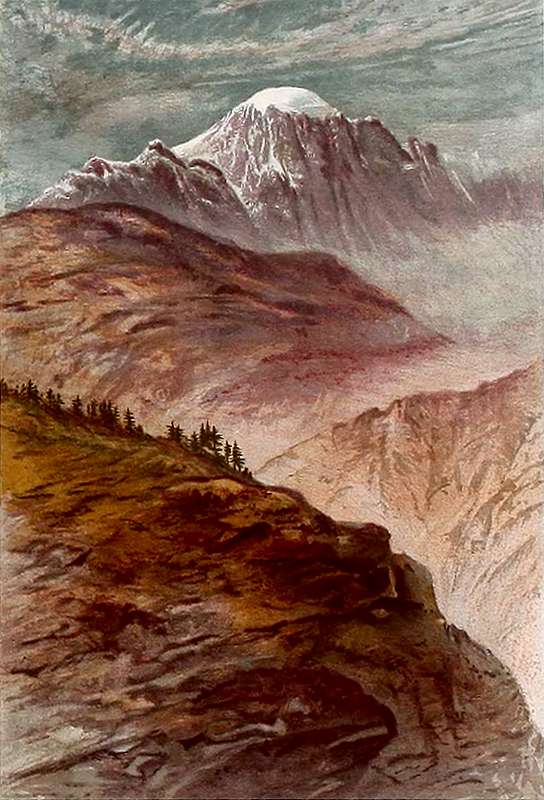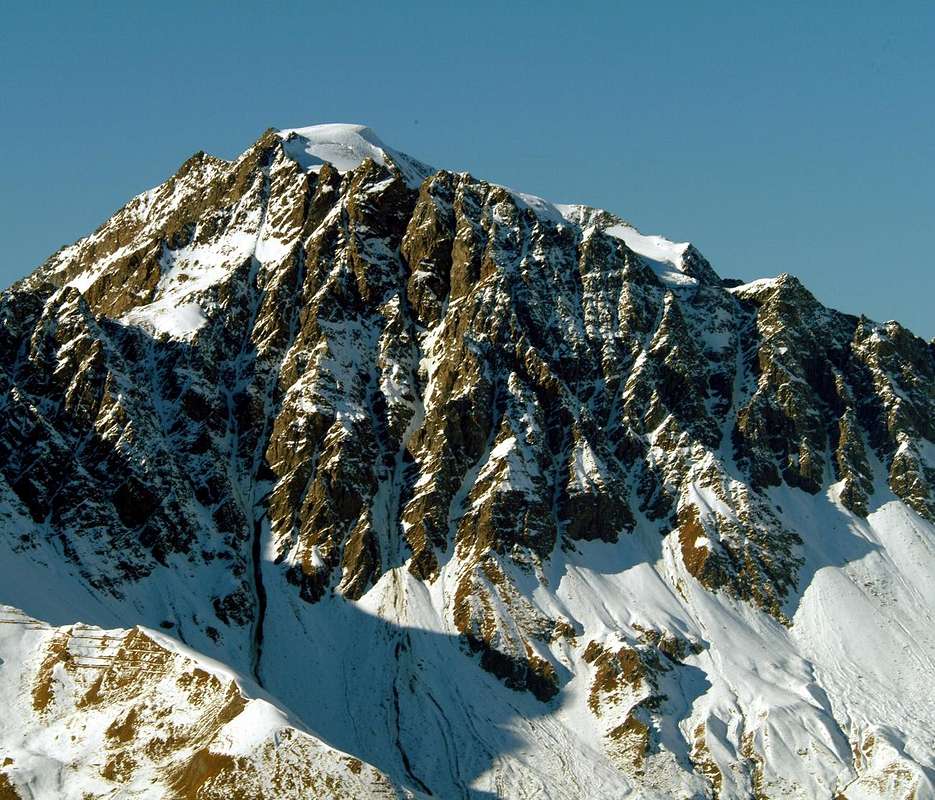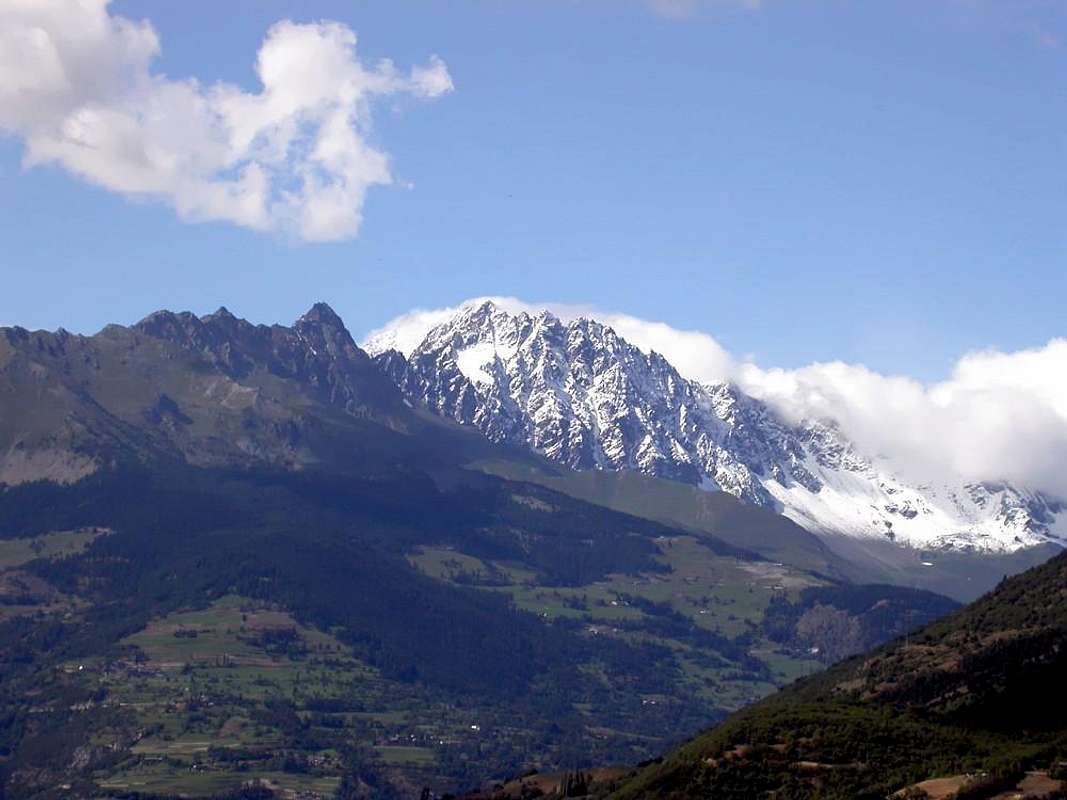può dare luogo ad un'ascensione glaciale interessante, ma pur sempre pericolosa. Tramite il settore di destra (Sud) di questa avvenne la prima ascensione del 31 Agosto 1779 anche se in maniera parziale, poiché il Canonico del San Bernardo, nonché Parroco di Liddes e grande amico del Naturalista Horace de Saussure, Murith ed il Cacciatore Genoud terminarono l'ascensione
sulla Cresta Ovest o d'Annibale sopra l'Aiguille du Dèjeuner. La Parete Nord invece é la più bella e difficile e nei suoi tre itinerari, compreso quello all'adiacente Aiguille du Velan (
. Su quella del 29 Luglio 1939 (Bonnant-Boulaz) é stata compiuta la prima invernale il 26 Gennaio 1964 da parte di François Beth, Jean Délère, André Praz e Jean-Jacques Saudan. Tutte in ogni caso sono assai raramente ripetute e qualcuna forse attende ancora la seconda salita. Infine le creste: detto già della Nordest dal Colle di Valsorey, rimangono quella Sud-sudovest dalla Sella di Faceballa, la Ovest dal Passo di Annibale e la Nord-nordovest che proviene dal Petit Velan scavalcando i Dents de Proz e l'Aiguille du Velan. La prima, discesa parzialmente nel 1890 e salita due volte nel 1904 con relativa prima ascensione invernale del Velan, conosce alcune varianti (1970) con aggiramenti o percorso integrale (1997); la seconda é una cresta facile e sicura percorsa in modo completo per la prima volta nel 1826, mentre la terza conosce immeritatamente scarsa frequentazione nonostante sia interessante e panoramica ma con percorso disomogeneo (passaggi in roccia fino al III°; prima ascensione da parte di W.B. Anderson, T. Ashby, C. L. e Tom G. longstaff con le Guide Svizzere Joseph Georges, Jean Maitre e Pierre Maurys il 18 agosto 1897). Un'ultima Cresta Nordest (da non confondere con quella di frontiera) divide, partendo dal Col de la Gouille per raggiungere la Calotta, i due Ghiacciai di Tseudet e Valsorey; risulta anche questa via raramente frequentata, anche se non difficile e molto panoramico. Il primo percorso porta la data del 3 Settembre 1872 ed é stato realizzato da H. J. e Walter Leaf accompagnati dalle Guide Hans Baumann e Daniele Bich.
But which is the real name of the Mont Velan, how to write and how to pronounce? Often we read Vélan with é acute, which makes very
"chic" but it is not exact. Someone comes to Velàn with the grave accent, but is even less fair. Velan, which comes from the Latin
"Villanus" and then Medieval
"Villan" is written simply
Velan, no accents of any kind; but it should be pronounced from as
V'lan by a liaison with that
"eats" the e and replaces those accents improper with a single and elegant apostrophe.
For the
"Guide des Alpes Valaisannes", Vol. I°, page 118 Marcel Kurz, Edit. C.A.S., 1963, the right is Velan pictograph writing and pronunciation precisely V'lan. Gino Buscaini in
"Pennine Alps Vol. I", page 172, Edit. C.A.I. / T.C.I., 1971, following consultation with the Philologist Prof. Charles Tauber Zurich makes note the presence of a Monte Vilan in Prattigan. Julius Studer the place name, see the Latin
"Vilanus" from
"vilis" that is of little value and also
"villosus" or rough. He concludes then with pasture of little value. In both cases we choose the second because there are good pastures around the Velan, at least on the Italian side, while at first glance the mountain looks pretty grim from everywhere it looks. Finally also the option of referring to the
"Villa", ie mountain pasture belonging to the country house, perplexing, although Agostino Ferrari in
"Bulletin C.A.I. No. 73, 1909", page 132, you see in this country the Montagne de Proz
(1956m) above Bourg Saint Bernard. Even the similarities with the alp vigil at the Monte Leone or Viletta and Vella in the Val d'Herens leave make any difference. I think, supported by the observation of Umberto Pelazza on page 73 of
"I wonder why it is called so for a walk in the Vocabulary of Aosta's Valley Mounts" over
Mount of Village taken by Kurz and Gueux, sees the noblest radical
VAL, VEL, a variant of
PAL or
Rock high. And in this direction personally prefer to conclude by referring to
Aiguille, Ouille, Gouille, as neighbors Northern Col de la Gouille and Mont de la Gouille, above the Velan Hutte.
![]() "Mons Villanus" or "Monte Villan" from South by Aosta Ville,
"Mons Villanus" or "Monte Villan" from South by Aosta Ville,
by SalVal
Ma quale é il vero nome del Mont Velan, come si scrive e come si pronuncia? Spesso troviamo scritto Vélan con la é acuta, il che fà molto
"chic" ma non é esatto. Qualcuno arriva a Velàn con l'accento grave, ma é ancora meno giusto. Velan, che deriva dal Latino
"Villanus" e poi Medioevale
"Villan" si scrive semplicemente
Velan, senza accenti di alcuna sorta; ma si dovrebbe pronunciare come
V'lan con una liaison, che
"mangiandosi" la e, sostituisce quegli accenti impropri con un elegante apostrofo.
Per la
"Guide des Alpes Valaisannes", Vol. I°, pag. 118 di Marcel Kurz, Edit. C.A.S., 1963 la giusta scittura é Velan e la pronuncia appunto V'lan. Per Gino Buscaini in
"Alpi Pennine Vol. I", pag. 172, Edit. C.A.I./T.C.I., 1971, a seguito di consultazione con il Filologo Prof. Carlo Tauber di Zurigo fà notare la presenza di un Monte Vilan nel Prattigan. Per Julius Studer il toponimo si rimanda al Latino
"Vilanus" da
"vilis" cioé di scarso valore ed anche 2villosus" ovvero ruvido. Conclude quindi con pascolo di poco valore. Nei due casi scegliamo il secondo poiché attorno al Velan esistono ottimi pascoli, almeno sul versante italiano, mentre a primo sguardo la montagna appare piuttosto arcigna da dovunque la si osservi. Infine anche la possibilità di fare riferimento al
"Villa", cioé alpeggio che appartiene alla casa di campagna, lascia alquanto perplessi, nonostante che Agostino Ferrari nel
"Bollettino C.A.I. n° 73, 1909", pag. 132, vede in questo paese la Montagne de Proz
(1956 m) sopra Bourg Saint Bernard. Anche le similitudini con l'alpe Veglia presso il Monte Leone oppure vella e Viletta nella Val d'Hèrens lasciano il tempo che trovano. a mio avviso, suffragato dalla osservazione di Umberto Pelazza a pag. 73 di
"Chissà perchè si chiama così a spasso nel Vocabolario dei Monti Valdostani", oltre
Monte del Villaggio ripreso da Kurz e Gueux, vede il più nobile radicale
VAL, VEL, variante di
PAL, ovvero
Roccia elevata. Ed in questa direzione preferisco personalmente concludere facendo riferimento ad
Aiguille, Ouille, Gouille come i vicini Col e Mont.
"V'lan from Monte Avril & Valsorey Hill or Northeast towards Great Saint Bernard & Grand Combin or Northwest ...",
by Antonio, sarme, andreaperino & livioz
Comments
No comments posted yet.







